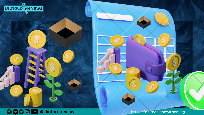What is Kwenta Prediction Market?
Kwenta is a DApp that leverages the Synthetix protocol, which means no creating an account, no deposits or withdrawals, and no surrendering custody of your funds.
Traders can long or short popular synthetic cryptocurrencies, commodities, forex, and equities without the limits or compromises of a centralized exchange. Kwenta lives on Optimism as well as L1, offering users low gas fees and near instant transactions.
DApp stands for decentralised application. Kwenta is a decentralized derivatives trading platform, offering 10x leverage for a limitless range of assets, powered by Synthetix. Kwenta is built on the Synthetix protocol, so the Synth liquidity traders can access on Kwenta is entirely created by SNX stakers on Synthetix.
Kwenta Unique Prediction Market Trading Features.
Infinite liquidity: All trading is peer-to-contract, using the Synthetix protocol’s pooled liquidity model. This means no counterparty matching, and essentially infinite liquidity for traders.
Permissionless and non-custodial: Kwenta is a dApp that leverages the Synthetix protocol, which means no creating an account, no deposits or withdrawals, and no surrendering custody of your funds.
Zero slippage: Infinite liquidity means that traders never have to worry about moving the orderbook and being affected by slippage.
Synthetic futures: Coming Soon, Once futures is built on the Synthetix protocol, it will soon be supported on Kwenta, offering perpetual future contracts on a non-custodial, permissionless platform.
Low gas fees and fast transactions: Kwenta can now be used on Optimism’s layer 2 solution for low gas fees and fast transactions.
Peer-to-contract (P2C) trading: All trades are executed against the Synthetix smart contracts, so traders don’t have to worry about the limitations of the peer-to-peer trading model, such as liquidity, slippage, or orderbooks
Skew bar and trade history: This new feature enables traders to get an order history panel that displays the last 50 global trades routed through the selected assets contract. As well as a new skew bar that visually displays open interest on either side of the market that conveniently sits directly on top of the trading history.
Average Funding Rate Calculation: Kwenta now displays a normalized 1-hour funding rate. The indicated funding rate is an average calculation, should be less volatile, more predictable, and more in line with what traders expect when it comes to funding intervals.
How To Trade on Kwenta.
Decentralized Prediction Market (DPM) Platform, Kwenta is built on the Synthetix protocol. What Synth liquidity traders can access on Kwenta is entirely created by SNX stakers on Synthetix. There are no direct counterparties for each trade in the Synthetix protocol, but it does use a counterparty-like model in which SNX stakers assume a proportion of the Synthetix debt pool when they mint sUSD.
Prediction Market transactions cost a certain amount proportional to how much processing power is required for Ethereum miners to process it. Kwenta uses the Synthetix protocol, which is far more complex than the majority of other Ethereum projects, so its transactions require more gas to be executed.
There are three simple steps on how to trade on Kwenta.
Step 1. You’ll need a web3 wallet with ETH for gas: Kwenta is on the Ethereum blockchain, so like all other dApps on Ethereum you’ll need a web3 wallet with ETH in it as gas to pay for transactions to be processed. Popular cryptocurrency wallet categories include hardware wallets, browser extension wallets, and mobile wallets.
Step 2: Acquire sUSD (or any other Synth) To start trading, you’ll need a synthetic asset derivative supported by Kwenta, known as Synths. The most accessible Synth is sUSD, which can be purchased on dApps such as Uniswap, Curve, or 1inch.
Step 3: Use Kwenta to trade the full range of SynthsOnce you’ve got sUSD or any other Synth, you can trade between the entire range of Synths to craft a diverse portfolio of assets, all on-chain and without surrendering custody to an exchange.
Kwenta Token.
Kwenta is listed on CoinMarketCap as an untracked token, nearly year after the Dapp announcement of going independent. The Dapp is in the process of listing it’s base token, watch out for airdrops.
The Synthetix-based Kwenta exchange announced that it is branching out on its own as it strives to become the leading decentralized finance (DeFi) trading hub.
In June 2021, the exchange explained its motivations for this independence effort and what it means for both Synthetix stakers and Kwenta users.
Kwenta is a rebranded successor to the synth trading interface Synthetix.Exchange, which is powered by the Synthetix DeFi platform.
The announcement explained that the Kwenta token will be used to bootstrap the community and fuel an early development team. This will be able to lead it towards becoming a self-sustaining platform.
The new token will complement the Synthetix community, it explained, adding value to Kwenta on its path to independence.
There were no details on official launch date other than “We’re aiming for summer” for the synthetic asset exchange.
Join the Kwenta Community
If you haven’t already, join the Kwenta community on Discord.
To learn more about how you can acquire a DAO role as a developer, marketer, governance contributor, or professional trader, visit our Documentation.
To be the first to learn about new updates to Kwenta, follow us on Twitter.
Discover more from DiutoCoinNews
Subscribe to get the latest posts sent to your email.












